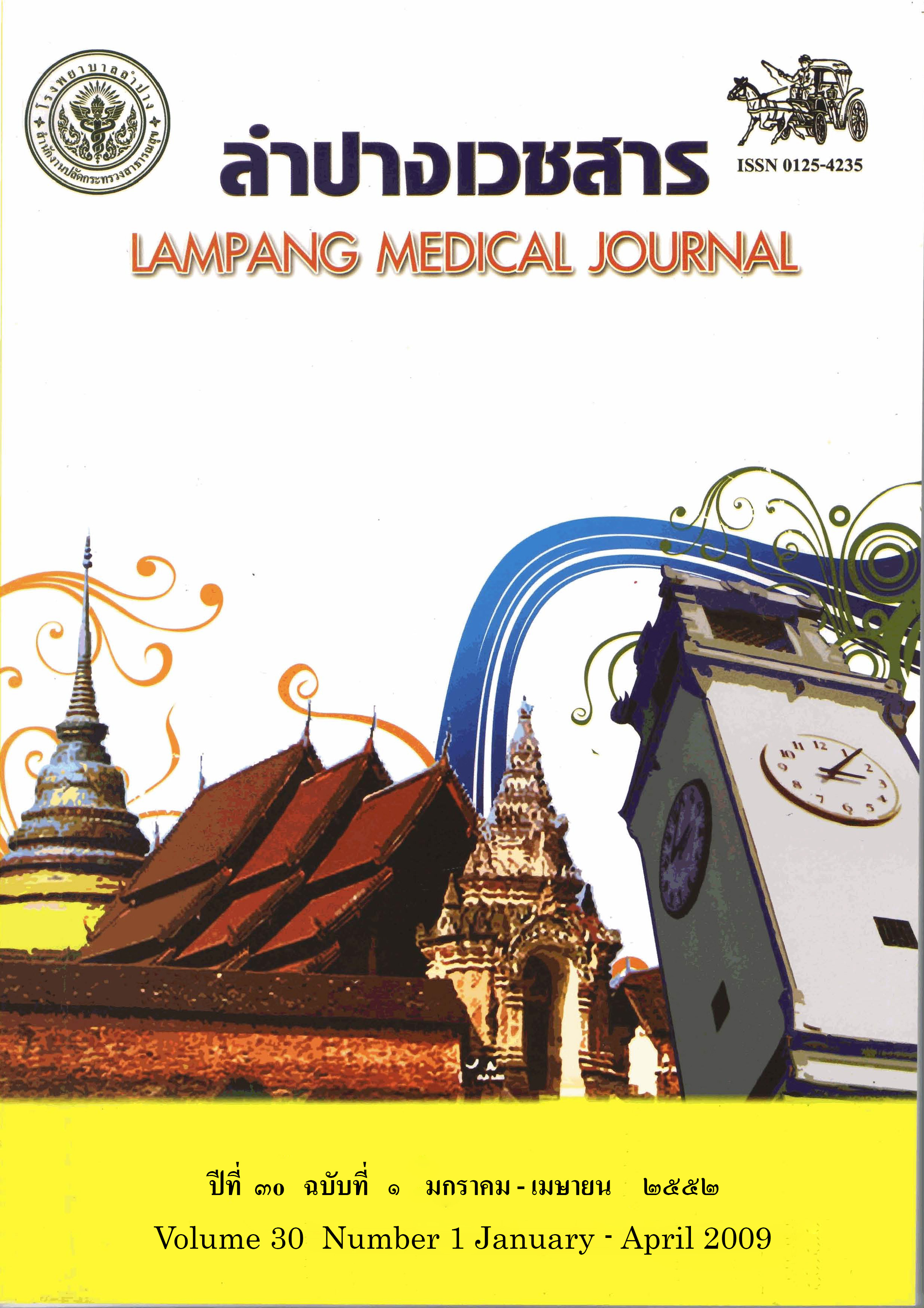Anemia in Pregnancy at Lampang Hospital : Prevalence, Causes and Risk Factors
Main Article Content
Abstract
Background : Anemia in pregnancy is one of the indicators representing quality of care in obstetrics. It could cause both maternal and infantile morbidity. Its prevalence has been widely reported with different criteria of diagnosis. A wide variety of risk factors were also mentioned in many studies. There is no official report of prevalence, causes or risk factors of this condition from Lampang Hospital.
Objective : To estimate prevalence, causes and risk factors of anemia in pregnancy at Lampang Hospital.
Material and method : Descriptive study with retrospective data collection of 385 cases of newly registered antenatal care pregnant women was conducted between August 2007 and February 2008. The obstetric and socioeconomic factors, underlying diseases, serum ferritin and hemoglobin level, mean corpuscular volume and reports of Thalassemia/ hemoglobinopathies workup were recorded. The data were analyzed by exact probability test, Wilcoxon rank-sum test and multiple logistic
regression.
Results : The prevalence of anemia in pregnancy was 22.1%. From these cases, 22.4% was caused by iron deficiency, 47.1% was found to be carrier of Thalassemia or hemoglobinopathies, while 4.7% was found to be diseases. There was 30.6% of anemia in pregnancy cases that definite diagnosis could not be drawn. Risk factors related to anemia were age of 35 years or more (OR=0.62, 95%CI= 0.48-0.81), numbers of abortion (OR=0.58, 95%CI=0.46-0.75) and having first antenatal care in the
second trimester (OR=2.77, 95%CI=1.87-4.10).
Conclusion : The prevalence of anemia in pregnancy at Lampang Hospital was moderate comparing to other hospitals in Thailand. Common causes were Thalassemia, hemoglobinopathies and iron deficiency. However, 30.6% of cases could not be filled into any definite diagnosis. There was a clue that these cases had only slight decrease of hemoglobin level. Only three risk factors were related to anemia in pregnancy, age of 35 years or more, numbers of abortion and having first antenatal care in
second trimester.
Article Details

This work is licensed under a Creative Commons Attribution-NonCommercial-NoDerivatives 4.0 International License.
บทความที่ส่งมาลงพิมพ์ต้องไม่เคยพิมพ์หรือกำลังได้รับการพิจารณาตีพิมพ์ในวารสารอื่น เนื้อหาในบทความต้องเป็นผลงานของผู้นิพนธ์เอง ไม่ได้ลอกเลียนหรือตัดทอนจากบทความอื่น โดยไม่ได้รับอนุญาตหรือไม่ได้อ้างอิงอย่างเหมาะสม การแก้ไขหรือให้ข้อมูลเพิ่มเติมแก่กองบรรณาธิการ จะต้องเสร็จสิ้นเป็นที่เรียบร้อยก่อนจะได้รับพิจารณาตีพิมพ์ และบทความที่ตีพิมพ์แล้วเป็นสมบัติ ของลำปางเวชสาร
References
Treatments for iron-deficiency anaemia in pregnancy. The WHO Reproductive Health Library [online] 2008 [cited 2008 May 24]. Available from: URL: http://www.who.int/rhl/pregnancy_childbirth/medical /anaemia/cfcom/en/.
Scholl TO, Reilly T. Anemia, iron and pregnancy outcome. J Nutr 2000; 130 Suppl 2: 443-7.
ประเทือง เหลี่ยมพงศาพุทธิ, ชยันตร์ธร ปทุมานนท์, ชไมพร ทวิชศรี. ผลของภาวะโลหิตจางในหญิงตั้งครรภ์ต่อน้ำหนักทารกแรกคลอดเมื่อครรภ์ครบกำหนดที่โรงพยาบาลลำปาง. วารสารวิชาการสาธารณสุข 2547;13 (4): 559-66.
กลุ่มงานสูตินรีเวชกรรมและวางแผนครอบครัว โรงพยาบาลลำปาง. สถิติผลการดำเนินงาน ประจำปี 2550. ลำปาง: สำนักงานปลัดกระทรวงสาธารณสุข; 2550.
พิชัย โชตินพรัตน์ภัทร, สมภพ ลิ้มพงศานุรักษ์, พงศ์ศักดิ์ จันทร์งาม. ความชุกของภาวะโลหิตจางในสตรีตั้งครรภ์ที่คลินิกฝากครรภ์ โรงพยาบาลจุฬาลงกรณ์. จุฬาลงกรณ์เวชสาร 2546; 47 (4): 223-30.
Cunningham FG, Leveno KJ, Bloom SL, Hauth JC, Gilstrap III LC, Wenstrom KD. Williams Obstetrics. 22nd ed. New York: Mc Graw-Hill; 2005.
Centers for Disease Control and Prevention. Recommendations to prevent and control iron deficiency in the United States. MMWR Recomm Rep [online] 1998 Apr [cited 2008 May 24]; 3 (47 RR-3):[2 screens]. Available from: URL: http://www.cdc.gov/mmwR/preview/mmwrhtml/
htm
Amatayakul K, Wiersinga A, Kulapongs Olson P. A study on anaemia of pregnancy in the low income northern Thai women. J Med Assoc Thai 1975; 58 (7): 83-91.
Chaturachinda K. Anaemia of pregnancy: an epidemiologic study. J Med Assoc Thai 1972; 55 (2): 94-100.
มานิต หงสวินิตกุล. ภาวะโลหิตจางในหญิงมีครรภ์ รพศ.อุดรธานี. วารสารการแพทย์กลุ่มเครือข่าย 6/2 2537; 2 (2): 59-65.
เสาวณี ชูติพงศ์. สาเหตุของโลหิตจางในสตรีมีครรภ์. วชิรเวชสาร 2537; 38 (2): 79-81.
สันติ มุ่งสันติ, บุญมี ชมดี. อุบัติการณ์ภาวะเลือดจางในหญิงฝากครรภ์ที่โรงพยาบาลสุรินทร์. วารสารเทคนิคการแพทย์และกายภาพบำบัด 2540; 9 (2): 67-72.
จุลพงศ์ อจลพงศ์. ภาวะโลหิตจางและฮีโมโกลบินผิดปกติในสตรีที่มาฝากครรภ์ที่โรงพยาบาลเชียงรายประชานุเคราะห์. วารสารวิชาการสาธารณสุข 2541; 7 (2): 205-12.
Areekul S, Ukoskit K, Yamarat P, Panatampon P, Tanapongpipatana S. Prevalence of anaemia in pregnant Thai women. J Med Assoc Thai 1976; 59 (12): 525-31.
Chotnopparatpattara P, Limpongsanurak S, Charnngam P. The prevalence and risk factors of anemia in pregnant women. J Med Assoc Thai 2003; 86 (11): 1001-7.
นวลอนงค์ ศรีธัญรัตน์, นพพร อารีย์วัฒนานนท์, ศิริลักษณ์ ทองสุทธิ์, สมร สีหบัณฑ์, นารีรัตน์ สุนทร พนาเวศ, ปริศนา สุวรรณภราดร และคณะ. การศึกษาปัจจัยเสี่ยงต่อการเกิดภาวะโลหิตจางเนื่องจากขาดธาตุเหล็กในหญิงตั้งครรภ์ในชุมชนเขตเทศบาลเมืองสุรินทร์. วิทยาสารพยาบาล วิทยาลัยพยาบาลสภากาชาดไทย 2543; 25 (2): 96-105.
ถวัลย์วงศ์ รัตนสิริ, ชุติมา เจริญสินทรัพย์. ความชุกของภาวะเลือดจางในสตรีตั้งครรภ์ที่มาฝากครรภ์ที่โรงพยาบาลศรีนครินทร์. ศรีนครินทร์เวชสาร 2547; 19 (4): 189-97.


